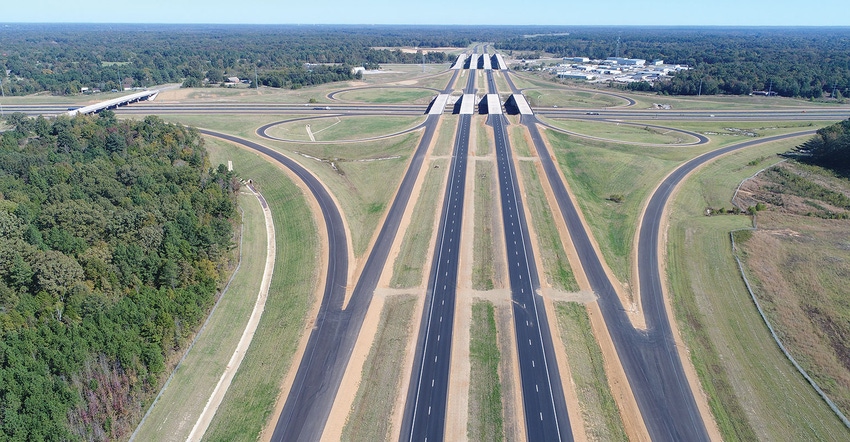
When the celebratory ribbon is cut to officially open the last 9 miles of I-269 this October, it will complete a 30-mile section of interstate connecting Hwy-61 on the south end, and I-55, I-22, and I-40 moving north, to the massive I-69 international interstate that one day will stretch from Mexico to Canada.
What officially began in 2011 is being called the “Crown Jewel” of recent highway construction projects by officials at the Mississippi Department of Transportation (MDOT). “While many portions of the much broader I-69 project have yet to be completely funded, the I-269 opening will provide travelers with a route that includes approximately 120 lane miles, 51 bridges, and 10 interchanges of full-control access,” explains Mike Tagert, northern district transportation commissioner, MDOT. “A project like this connects an important farm-to-market network for growers in Mississippi, Tennessee, Arkansas and the entire Mid-South.”
Twenty-one miles of the new thoroughfare has been open and stretches past the Tennessee state line. The agonizingly slow design, planning, and public comment period began back in the 1990s, before the federal government gave the environmental “thumbs up” to begin groundbreaking.
The price tag for the Mississippi portion of the project will be close to $640 million. While the exact date for the last section of I-269 to officially open has yet to be announced, it would be a little ironic if it happens on Sept. 20 — the 68th anniversary of the completion of Interstate 55 through Desoto County, Miss.
As in agriculture, drones are starting to be used by MDOT and other transportation agencies across the United States to inspect roads and bridges. During an MDOT press event in April, a 10-pound drone was used to demonstrate how aerial inspections are conducted. “Drones allow us to inspect bridges and miles of roadway quickly,” adds Tagert.
Agriculture and Economic Development
Consolidated Grain and Barge (CGB) has a location on Mhoon Landing Parkway in Tunica, Miss. Officials there understand fully the potential impact on their businesses the opening of this last section of I-269 will have. “We’ve had meetings with our insurance group, our staff, and our management,” explains Joseph Masters, grain originator, CGB. “By referencing geo-maps, we have estimated there are several million bushels of grain that could possibly be added to our operation annually.”
That estimate is not concrete and could fluctuate based on each year’s yields and cotton acres. The average ticket time at the Tunica facility is roughly 6 minutes. “The farmers we have spoken to say they’ll be able to make the trip down here, turn around after unloading and get back to their operations in less time than it normally takes them to negotiate the often-bottlenecked I-240 loop in Memphis on their way to the grain facilities located on President’s Island,” says Masters.
John Sullivan farms in both Mississippi and Tennessee. He has been taking trucks filled with his grains to the Memphis River Ports for many harvest seasons. Even though it may be a few more miles to the Tunica-based CGB facility, he believes it will be faster than going through Memphis traffic. “Most farmers I’ve spoken with are pretty excited about have another thoroughfare option for sure,” says Sullivan. “It gives us another place to market our corn and soybeans.”
In addition to the obvious impact on agricultural product trucking operations, the economic development potential is massive. “Many communities would give anything to have one fully-controlled interstate grade access point around which they could establish manufacturing, logistics, and warehousing opportunities,” adds Tagert. “This project contains 10!”
The I-269 corridor will also benefit the largest freight railroad in North America, BNSF Railway Company. “With the volume of freight shipped via trucks and rail each year, BNSF and those they serve will most assuredly benefit from the opening of the final phase of I-269, says Tagert. “It’s a huge opportunity for many industries, but for this region, few, if any, more important than agriculture.”
About the Author(s)
You May Also Like




